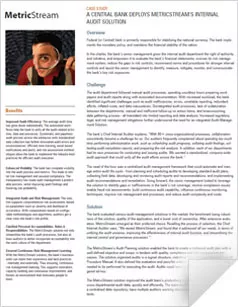
AI-First Connected GRC
Drive a Connected GRC Program for Improved Agility, Performance, and Resilience
Discover Connected GRC Solutions for Enterprise and Operational Resilience
Explore What Makes MetricStream the Right Choice for Our Customers
Discover How Our Collaborative Partnerships Drive Innovation and Success
- Want to become a Partner?
Find Everything You Need to Build Your GRC Journey and Thrive on Risk
Learn about our mission, vision, and core values
Intelligent Regulatory Compliance Reporting with XBRL
Overview
Businesses have dealt with financial data, information, reporting, and disclosures what they have not dealt with is the amount of accuracy and reliability companies require these days. Regulations, legislations have always been there, what has changed is their rigor. Clearly making regulatory environment very complex and severe and also leaving the companies grappling with ways on how they go about demonstrating, documenting and reporting compliance

Requirements change as regulations are amended and expanded. The constantly evolving standards of regulations cause strains in the relationships between companies and their external auditors. Such changes disrupt the way companies meet their compliance needs. The Securities and Exchange Commission (SEC) require companies to provide information more quickly and mandates that high-level executives sign off on the accuracy of financial statements. They are also calling on companies to provide information in an easily understandable format that supports evaluative and trend analysis1. For the large companies, it applies beginning from June 2009, for all public companies within the next three years. Compliance with a regulatory mandate and plethora of guidelines- is inherently difficult.
However the common challenges most regulators face in their reporting procedures include6:
- Securely obtaining data that can be entered automatically and seamlessly into systems without re-keying, reformatting or other translation effort
- Reducing costs through automating of routine tasks
- Quickly and automatically identifying errors and problems with fillings
- Validating, analyzing and comparing data quickly, efficiently and reliably
- Shifting focus of effort more on analysis and decision-making with filers rather than on data manipulation
- Promoting efficiencies and cost savings through the regulatory filling process
The challenges and financial burdens do more than just encourage companies to find better and efficient ways - drive usage of eXtensible Business Reporting Language (XBRL).
Instead of treating financial information as a block of text - as in a standard Internet page or a printed document - XBRL provides an identifying tag for each individual item of data. The introduction of XBRL tags enable automated processing of business information, allowing the data to be treated “intelligently”3.
This greatly increases the speed of handling financial data, reduces the chance of error and permits automatic checking of information. Use of XBRL reduces the cost of analyzing performance data and makes comparative analysis of multiple companies’ easier, improving transparency. XBRL provides a standardized manner by which data in financial statements can be described—it does not change the data2.
Why regulators should adopt XBRL?
The worldwide adoption of XBRL has not come as a surprise. The factors driving the adoption of XBRL are the process efficiencies, information transparency, and significant cost saving that it brings in dissemination and analysis1. These are the key processes in regulatory compliance.
Evidently XBRL adoption does not only improve efficiency, control risks, and introduce enhanced flexibility in the way companies manage their business and respond to the constant change and fluid environment in which they operate, but also3:
- XBRL is an open source technology, requires no annual subscription and licensing fee - High costs associated with the establishment of effective internal control systems mandated by Section 404 of Sarbanes-Oxley can be significantly reduced.
- XBRL’s automation of the audit process permits the maintenance of accurate audit work papers - Section 103 not only requires that audit work papers be preserved for seven years but also that such records reflect transactions “accurately and fairly in reasonable detail.”
- XBRL allows data retention even when moved between applications -SoX’s manual audit trail requires the transfer of information between applications such as from corporation’s accounting information system to auditor’s analysis software.
- XBRL retains data in the same structure as the source -The audit process is automated and control is enhanced.
- XBRL allows “real-time disclosures” with its ability to improve data processing and publishing efficiency - Section 409 of SOX, requires that a company posses reliable systems, a common method of information dissemination, corporate accountability, and understandable disclosures (AICPA).
- XBRL reduces the asymmetry between internal management information and external public information in the company’s general ledger - The public can make investment decisions based on the most current and up-to-date information possible instead of information that is 60 days old as is the case with traditional audits.
What are the challenges in implementing XBRL?
XBRL offers major benefits at all stages of business reporting and analysis. It has world wide relevance, is intended to support all current aspects of reporting in different countries and industries. But has some challenges associated with its implementation. Some of them are as follows:
- XBRL requires experts with skills in accounting, finance, computer programming, and XBRL-specific knowledge. Such talents are easy to acquire but can be a deterrence to widespread adoption.
- XBRL's real-time reporting capabilities require implementation of additional controls to ensure the accuracy and integrity of the data that is captured.
- Companies must make sure that the taxonomy they use to prepare financial statements is appropriate and that the procedures for tagging data are complete and accurate5.
- The online nature of XBRL reporting presents additional security risks. Companies will need to provide end-to-end security for all XBRL communication, including authentication, access control, malicious attack protection, non-repudiation, and data privacy5.
Conclusion
Though XBRL is not a magic bullet -it has its share of challenges. But it’s a breakthrough in the reporting technology. It’s a technological tool that possesses many benefits for businesses, corporate managers, accountants, regulators, and the general public. It can fulfill your compliance requirements by capturing your vital business information and if used properly it can yield benefits to a wide spectrum of audience. Implement XBRL for a cleaner, more accurate data increased productivity and greater efficiency and measurable ROI and bottom line impact.
Metric Stream’s support for XBRL
MetricStream provides support for XBRL for publishing reports in XML to various regulatory agencies. Various data elements can be mapped based on appropriate taxonomy and published using XBRL. MerticStream is committed to an open architecture and extensibility is a key aspect of our platform. We will continue to enhance our interfaces to conform to the XBRL standard.
References
- David Coderre, ‘Are You Ready For XBRL?’ Audit Principal, Royal Canadian Mounted Police, September 15, 2004
- XBRL International in 2002 and Beyond, http://xml.coverpages.org/XBRL2002.pdf
- Linus Akanoh, Jr., ‘Using XBRL for Regulatory Compliance and Increasing Financial Reporting Efficiency,’ St. Edward’s University, http://www.stedwards.edu/business/pdf/Perspectives_V3N1_03.pdf
- Gianluca Garbellotto, ‘Extensible Business Reporting Language (XBRL): What’s in it for Internal Auditors’, The Institute of Internal Auditors Research Foundation, February, 2009.
- Michael Smith, French Caldwell, Mary Knox, ‘XBRL mandate on financial reporting will improve transparency,’ Gartner Research, December 19, 2008.
- FFIEC Federal Financial Institutions Examination Council, Improved Business Process Through XBRL: A Use Case for Business Reporting, 2006.

Subscribe for Latest Updates
Subscribe Now





